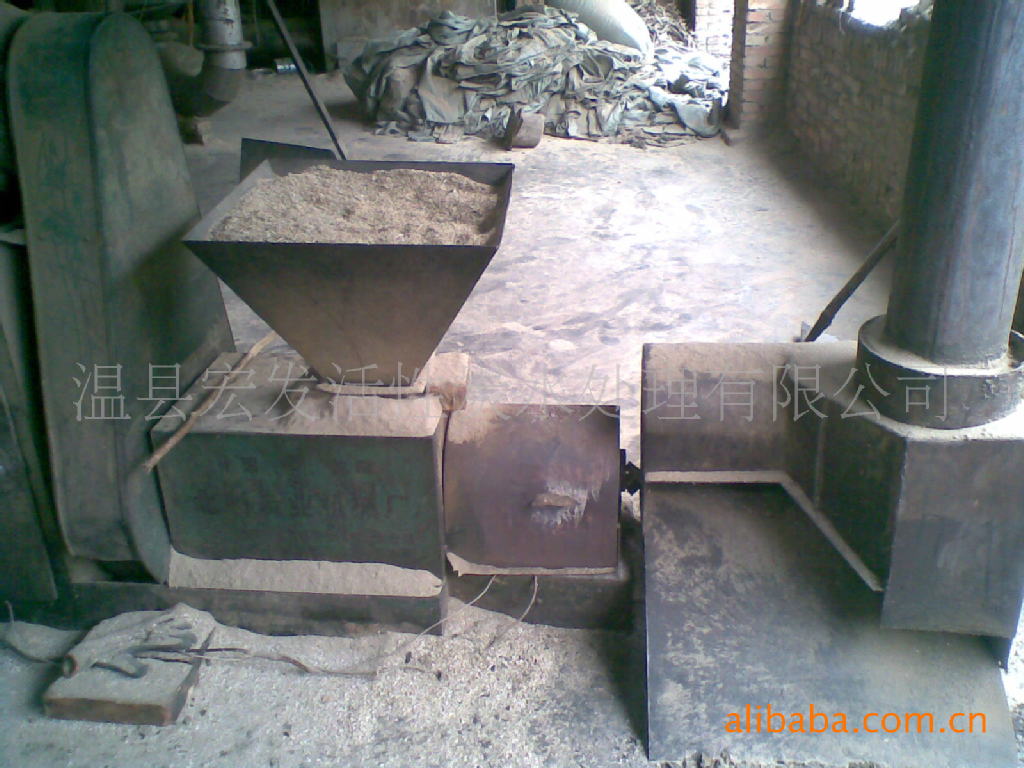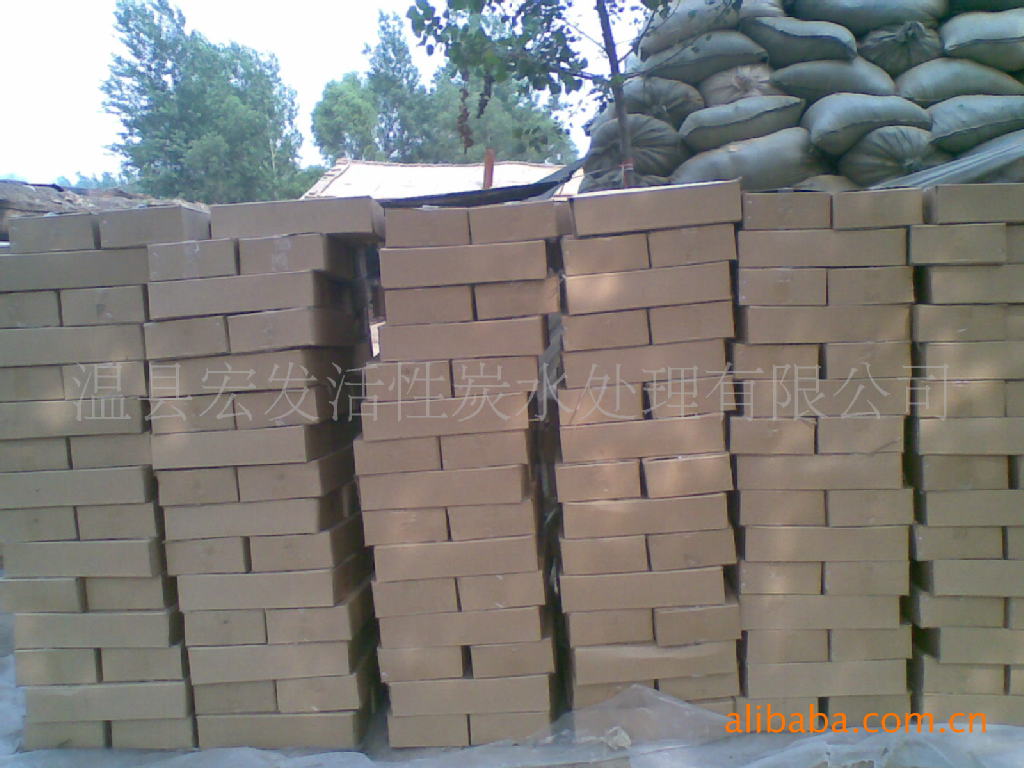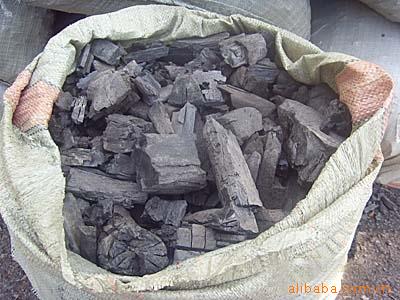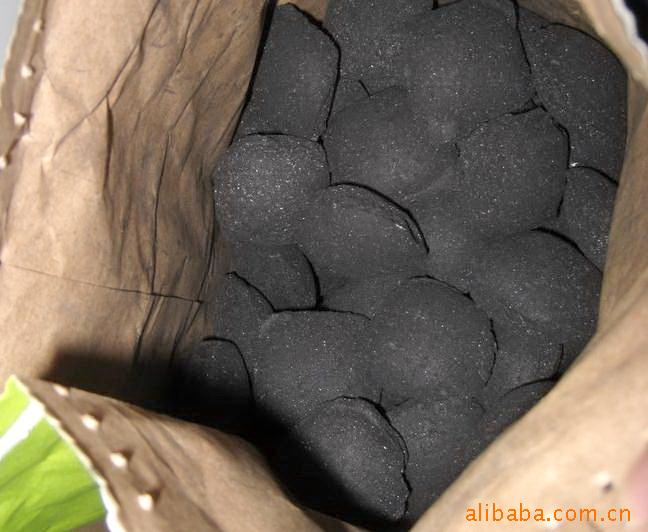
优质工业木炭 // 果木木炭==高温机制木炭//出口机制木炭
1.冶金工业以前木炭就用来冶炼铁矿石,木炭与焦炭熔炼的生铁,即使化学组成相同,其结构与机械性质仍不相同。木炭冶炼的生铁一般具有细粒结构,铸件紧密,没有裂纹的特点,用木炭生产的生铁含杂质少,适于生产优质钢。由于木炭具有还原性,所以在冶金工业可以用来还原矿石冶炼金属。
在有色金属生产中,木炭常用作表面助熔剂,当有色金属熔融时,表面助熔剂在熔融金属表面形成保护层,使金属与气体介质分开,既可减少熔融金属的飞溅损失,又可降低熔融物中气体的饱和度。
大量木炭还用于结晶硅生产,生产结晶硅用的木炭不应含有生炭头和过多的灰分。
2.渗碳剂的制造
凡是要求表面具有较高的硬度和耐磨性,而中心具有良好韧性的所有钢制品都要进行渗碳。用来对钢制品进行渗碳作用的含碳混合物称为渗碳剂。单纯木炭的渗碳效果较差。因此常用木炭作为原料,再加入一定数量的接触剂,制成渗碳剂。
3.二硫化碳生产......
木炭是制造二硫化碳的最好原料,用来制造二硫化碳的木炭,应当是坚硬、容积重大、灰分和水分含量小,固定碳含量高。
生产1吨二硫化碳约需0.5吨的木炭
4.木炭砖的压制
碎木炭运输很不方便,而且用途也受到限制,用压制木炭砖的方法能使价值很小的碎木炭变成优质燃料。木炭砖具有吸湿性和吸水性小、比重大和热值高的优点,而且在使用过程有很高的机械强度。煅烧过的木炭砖在燃烧时无烟,不产生炭尘。木炭砖可用于冶金、移动式气化炉等。....
机制木炭,大家平常简称机制炭、再生木炭、人造炭、环保木炭、无烟炭等。机制木炭最先由日本研制,产品称"木力亏仆",后传到台湾,然后才转到内地来的!
机制木炭是什么样的呢?通常外型为直径5厘米左右的四角形、六角形和圆形三种,长度可以任意截取,一般为8到50厘米长,中间有一小孔,方面通气用!机制木炭所用原来通常为木屑和竹屑,经专门的制棒机高温高压挤压成型,当然原材料在使用前是要用烘干机烘到只含水分10%以下!很多人以为稻壳、花生壳、玉米芯、玉米秆、高粱秆等也可以烧制成炭,是没错,用这些材料可以压制成棒,可不能炭化成木炭!为什么呢?因为这些材料所含纤维构造不同和元素不一样,使得在使用后所剩的灰粉很多,燃烧值也很低,火力不够大!
机制木炭因为经过高压高温,所以密度很大,是一般木材的2到3倍,也是自然木炭的3倍左右!更是泥煤、焦炭的4到5倍!相当于无烟煤的比重(无烟煤1350~1800千克/立方米)!虽然我国煤炭资源丰富,但高硫份、高灰份的煤炭较多,而低硫份、低灰份的煤炭较少。比如我国动力煤平均灰份为28%-30%,煤炭中的含硫量也很高,全国平均为1-1.2%,南部地区普遍高达4%以上。这些煤炭如果不加处理即直接燃用,就会产生严重的二氧化硫和烟尘污染。而机制木炭更本解决了这个问题,它所含的灰份仅少于5%,发热量也能达到7000-8000大卡/KG!机制木炭在炭化窑里炭化的过程中,已经把大部分有害物质燃烧,分解了!所以机制木炭具有比重大(密度高)、热值高、成本低、使用方便、清洁卫生等优点,便于贮存和运输,是居民生活、取暖和工业生产用能,可替代煤炭等,燃烧后的固体(灰粉)排放量低于煤炭,减少了废渣排放,也比较方便处理,基本没有环境污染问题;气体排放指标大大优于国家气体排放标准。
机制木炭的市场广阔。饭店、工厂、农业、畜牧业、冶金、环保、实验等///////////////
1. Metallurgical industry
Previously used for smelting iron ore, charcoal on charcoal and coke smelting of iron, even if the same chemical composition, structure and mechanical properties are still the same. Charcoal smelting of pig iron generally has fine structure, casting tight, no cracks in the characteristics of the production of pig iron using charcoal containing impurities less suitable for producing high quality steel. As the charcoal is reductive, so can be used to restore the metallurgical industry ore smelting metal.
In the non-ferrous metal production, charcoal is often used as surface flux, when the non-ferrous metal melting, the surface flux in the molten metal surface protective layer, so that separation of metals and gases, can reduce the loss of molten metal splash, but also reduce the melting material in gas saturation.
A large number of charcoal is also used to produce crystalline silicon, crystalline silicon used in charcoal production should not contain too many students head and charcoal ash.
2. Carburizing agent manufacturing
All requirements of high surface hardness and wear resistance, good toughness and the center of all steel products should be cementite. Carburizing of steel products used to carry out the role of carbon compounds known as carburizing agent. Carburizing pure charcoal less effective. Therefore, charcoal used as a raw material, then add a certain amount of contact with agents, made of carburizing agent.
3. Disulfide production..
Charcoal is the manufacture of carbon disulfide in the best raw materials used to produce carbon disulfide in the charcoal, should be hard, great volume, ash and moisture content in small, fixed carbon content.
Produce about 1 ton of carbon disulfide, 0.5 tons of charcoal.
4. Charcoal brick repression
Crushed charcoal transport is very convenient, but use is restricted, with the suppression of the value of charcoal bricks in the way that it can become a high-quality small pieces of charcoal fuel. Charcoal bricks with water absorption and water absorption of small, heavy, and the advantages of high calorific value, but also in the process of using a high mechanical strength. Burning off burning charcoal bricks in a smoke-free, does not produce carbon dust. Charcoal brick can be used for metallurgy, such as mobile gasifier.
Mechanism charcoal, we normally referred to as charcoal, charcoal regeneration, artificial carbon, green charcoal, charcoal and other smoke-free. First developed by the Japanese machine-made charcoal, the product called "wood strength loss servant", after the journey to Taiwan before coming to the mainland!
What is the mechanism of charcoal like? The outline is usually about 5 cm in diameter square, hexagonal and round three, the length can be any interception, usually 8-50 cm long, the middle of a small hole, side ventilation with! Mechanism of charcoal is usually used in the original wood and bamboo cuttings, by special rods for high pressure extrusion molding machine, of course, is the use of raw materials before using the dryer drying to moisture content below 10% only! Many people think that rice husk, peanut shell, corn cob, corn stalks, sorghum stalks, etc. can also be fired into carbon, is yes, with these materials can be compressed into bars, can not be carbonized into charcoal! Why?
Because these materials contained in the fiber structure and different elements are different, making the remaining ash after use a lot of value is very low burning, fire is not big enough!
Mechanism charcoal because after high pressure high temperature, so much the density is generally 2 to 3 times the timber is about 3 times the natural charcoal! Is peat, coke 4 to 5 times! Equivalent to the proportion of anthracite (Anthracite 1350 ~ 1800 kg / cubic meter)! Although rich in coal resources, but high sulfur and high ash coal more, while low-sulfur, low ash coal less. Example, the average Chinese steam coal ash is 28% -30%, the sulfur content of coal is also high, the national average of 1-1.2%, in the southern region in general as much as 4%. The coal that is, if not addressed directly to fuel use,
Will cause serious pollution of sulfur dioxide and soot. The mechanism of charcoal also the solution of this problem, it contains only less than 5% ash, the heat can reach 7000-8000 kcal / KG! Mechanism of carbonized charcoal kiln in the process of carbonization, has the most harmful substances in combustion, decomposition of the! So has the proportion of machine-made charcoal (high density), high heat value, low cost, easy to use, clean the advantages of easy storage and transport, is living, heating and industrial production, energy use, and can replace coal, combustion solid (ash) emissions than coal
Reduction of waste emissions, but also easier to handle, little environmental pollution; gas emission targets much better than the national gas emission standards.
Mechanism charcoal vast market. Hotels, factories, agriculture, animal husbandry, metallurgy, environmental protection and experiment!
Charcoal
1.冶金工业
以前木炭就用来冶炼铁矿石,木炭与焦炭熔炼的生铁,即使化学组成相同,其结构与机械性质仍不相同。木炭冶炼的生铁一般具有细粒结构,铸件紧密,没有裂纹的特点,用木炭生产的生铁含杂质少,适于生产优质钢。由于木炭具有还原性,所以在冶金工业可以用来还原矿石冶炼金属。
在有色金属生产中,木炭常用作表面助熔剂,当有色金属熔融时,表面助熔剂在熔融金属表面形成保护层,使金属与气体介质分开,既可减少熔融金属的飞溅损失,又可降低熔融物中气体的饱和度。
大量木炭还用于结晶硅生产,生产结晶硅用的木炭不应含有生炭头和过多的灰分。
2.渗碳剂的制造
凡是要求表面具有较高的硬度和耐磨性,而中心具有良好韧性的所有钢制品都要进行渗碳。用来对钢制品进行渗碳作用的含碳混合物称为渗碳剂。单纯木炭的渗碳效果较差。因此常用木炭作为原料,再加入一定数量的接触剂,制成渗碳剂。
3.二硫化碳生产
木炭是制造二硫化碳的最好原料,用来制造二硫化碳的木炭,应当是坚硬、容积重大、灰分和水分含量小,固定碳含量高。
生产1吨二硫化碳约需0.5吨的木炭。
4.木炭砖的压制
碎木炭运输很不方便,而且用途也受到限制,用压制木炭砖的方法能使价值很小的碎木炭变成优质燃料。木炭砖具有吸湿性和吸水性小、比重大和热值高的优点,而且在使用过程有很高的机械强度。煅烧过的木炭砖在燃烧时无烟,不产生炭尘。木炭砖可用于冶金、移动式气化炉等。
机制木炭,大家平常简称机制炭、再生木炭、人造炭、环保木炭、无烟炭等。机制木炭最先由日本研制,产品称"木力亏仆",后传到台湾,然后才转到内地来的!
机制木炭是什么样的呢?通常外型为直径5厘米左右的四角形、六角形和圆形三种,长度可以任意截取,一般为8到50厘米长,中间有一小孔,方面通气用!机制木炭所用原来通常为木屑和竹屑,经专门的制棒机高温高压挤压成型,当然原材料在使用前是要用烘干机烘到只含水分10%以下!很多人以为稻壳、花生壳、玉米芯、玉米秆、高粱秆等也可以烧制成炭,是没错,用这些材料可以压制成棒,可不能炭化成木炭!为什么呢?因为这些材料所含纤维构造不同和元素不一样,使得在使用后所剩的灰粉很多,燃烧值也很低,火力不够大!
机制木炭因为经过高压高温,所以密度很大,是一般木材的2到3倍,也是自然木炭的3倍左右!更是泥煤、焦炭的4到5倍!相当于无烟煤的比重(无烟煤1350~1800千克/立方米)!虽然我国煤炭资源丰富,但高硫份、高灰份的煤炭较多,而低硫份、低灰份的煤炭较少。比如我国动力煤平均灰份为28%-30%,煤炭中的含硫量也很高,全国平均为1-1.2%,南部地区普遍高达4%以上。这些煤炭如果不加处理即直接燃用,就会产生严重的二氧化硫和烟尘污染。而机制木炭更本解决了这个问题,它所含的灰份仅少于5%,发热量也能达到7000-8000大卡/KG!机制木炭在炭化窑里炭化的过程中,已经把大部分有害物质燃烧,分解了!所以机制木炭具有比重大(密度高)、热值高、成本低、使用方便、清洁卫生等优点,便于贮存和运输,是居民生活、取暖和工业生产用能,可替代煤炭等,燃烧后的固体(灰粉)排放量低于煤炭,减少了废渣排放,也比较方便处理,基本没有环境污染问题;气体排放指标大大优于国家气体排放标准。
机制木炭的市场广阔。饭店、工厂、农业、畜牧业、冶金、环保、实验等!
1. Metallurgical industry
Previously used for smelting iron ore, charcoal on charcoal and coke smelting of iron, even if the same chemical composition, structure and mechanical properties are still the same. Charcoal smelting of pig iron generally has fine structure, casting tight, no cracks in the characteristics of the production of pig iron using charcoal containing impurities less suitable for producing high quality steel. As the charcoal is reductive, so can be used to restore the metallurgical industry ore smelting metal.
In the non-ferrous metal production, charcoal is often used as surface flux, when the non-ferrous metal melting, the surface flux in the molten metal surface protective layer, so that separation of metals and gases, can reduce the loss of molten metal splash, but also reduce the melting material in gas saturation.
A large number of charcoal is also used to produce crystalline silicon, crystalline silicon used in charcoal production should not contain too many students head and charcoal ash.
2. Carburizing agent manufacturing
All requirements of high surface hardness and wear resistance, good toughness and the center of all steel products should be cementite. Carburizing of steel products used to carry out the role of carbon compounds known as carburizing agent. Carburizing pure charcoal less effective. Therefore, charcoal used as a raw material, then add a certain amount of contact with agents, made of carburizing agent.
3. Disulfide production
Charcoal is the manufacture of carbon disulfide in the best raw materials used to produce carbon disulfide in the charcoal, should be hard, great volume, ash and moisture content in small, fixed carbon content.
Produce about 1 ton of carbon disulfide, 0.5 tons of charcoal.
4. Charcoal brick repression
Crushed charcoal transport is very convenient, but use is restricted, with the suppression of the value of charcoal bricks in the way that it can become a high-quality small pieces of charcoal fuel. Charcoal bricks with water absorption and water absorption of small, heavy, and the advantages of high calorific value, but also in the process of using a high mechanical strength. Burning off burning charcoal bricks in a smoke-free, does not produce carbon dust. Charcoal brick can be used for metallurgy, such as mobile gasifier.
Mechanism charcoal, we normally referred to as charcoal, charcoal regeneration, artificial carbon, green charcoal, charcoal and other smoke-free. First developed by the Japanese machine-made charcoal, the product called "wood strength loss servant", after the journey to Taiwan before coming to the mainland!
What is the mechanism of charcoal like? The outline is usually about 5 cm in diameter square, hexagonal and round three, the length can be any interception, usually 8-50 cm long, the middle of a small hole, side ventilation with! Mechanism of charcoal is usually used in the original wood and bamboo cuttings, by special rods for high pressure extrusion molding machine, of course, is the use of raw materials before using the dryer drying to moisture content below 10% only! Many people think that rice husk, peanut shell, corn cob, corn stalks, sorghum stalks, etc. can also be fired into carbon, is yes, with these materials can be compressed into bars, can not be carbonized into charcoal! Why?
Because these materials contained in the fiber structure and different elements are different, making the remaining ash after use a lot of value is very low burning, fire is not big enough!
Mechanism charcoal because after high pressure high temperature, so much the density is generally 2 to 3 times the timber is about 3 times the natural charcoal! Is peat, coke 4 to 5 times! Equivalent to the proportion of anthracite (Anthracite 1350 ~ 1800 kg / cubic meter)! Although rich in coal resources, but high sulfur and high ash coal more, while low-sulfur, low ash coal less. Example, the average Chinese steam coal ash is 28% -30%, the sulfur content of coal is also high, the national average of 1-1.2%, in the southern region in general as much as 4%. The coal that is, if not addressed directly to fuel use,
Will cause serious pollution of sulfur dioxide and soot. The mechanism of charcoal also the solution of this problem, it contains only less than 5% ash, the heat can reach 7000-8000 kcal / KG! Mechanism of carbonized charcoal kiln in the process of carbonization, has the most harmful substances in combustion, decomposition of the! So has the proportion of machine-made charcoal (high density), high heat value, low cost, easy to use, clean the advantages of easy storage and transport, is living, heating and industrial production, energy use, and can replace coal, combustion solid (ash) emissions than coal
Reduction of waste emissions, but also easier to handle, little environmental pollution; gas emission targets much better than the national gas emission standards.
Mechanism charcoal vast market. Hotels, factories, agriculture, animal husbandry, metallurgy, environmental protection and experiment!













